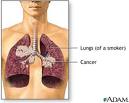
| Lung cancer occurs when cancerous cells develop in the lung’s tissue. It is the most common fatal cancer among men and women, and it is the number one killer in the world. Lung cancer has the highest mortality rate out of all the cancers combined. People with risk factors for developing the disease should have regular checkups to determine if they are cancer free. It is vital as with most cancers to have an early diagnosis and therefore gain treatment quickly to bring about a positive outcome. Cancers can sometimes appear as flat growths that are blue-brownish in colour, or as a red rash, or small crusty bumps. It is vital to pull back the foreskin regularly to check because often it is the only time these symptoms are visible. It occurs on areas of the skin that have been in the sun, such as the ears, lower lip, and the back of the hands. Squamous cell carcinoma may also appear on areas of the skin that have been burned or exposed to chemicals or radiation. Often this cancer appears as a firm red bump. In the next stages of lung cancer you can expect someone to show such symptoms trouble in breathing or shortness of breath. They will have blood in their saliva as well. They may also get pneumonia. In the more severe stages they will have pain in their chest and it will be relatively constant, sometimes overbearing. Many of the symptoms of lung cancer are nonspecific. In many patients, the cancer has already spread beyond the original site by the time they have symptoms and seek medical attention. About 10% of people with lung cancer do not have symptoms at diagnosis. Due to the high incidence of breast cancer among older women, screening is now recommended in many countries. Recommended screening methods include breast self-examination and mammogram. This test has been estimated to reduce breast cancer-related mortality by 20-30%. Routine and annual mammography of women older than age 40 or 50 is recommended. There are of course triggers that can spread things along. Factors such as lifestyle, which includes genetics, environment and diet, all play a role in increasing your risk to contracting one of the cancer’s. Sometimes there is a no known cause, no family history, a good lifestyle and dietary habits, It just happens. There are a few know lifestyle do’s and don’ts that may help you not to contact cancer and also to stand a better change of survival if you do contact cancer. Most cancers will present themselves in some form of symptom which will alert the sufferer to visit their doctor. Unfortunately there are some cancers which show no signs at all until the cancer has spread. A specialist will carry out many tests, often a scan, biopsy and x-rays. Fluctuations or abnormalities in hormonal levels in your body most likely cause both endometriosis and ovarian cancer. According to studies, women with endometriosis are also more likely to develop ovarian cancer in their lifetime. Sometimes, if the lung cancer that has spread to the bones it may produce excruciating pain at the sites of bone involvement. Cancer that has spread to the brain may cause a number of symptoms that may include blurred vision, headaches, seizures, or weakness or loss of sensation in parts of the body. By Gupta12 |











